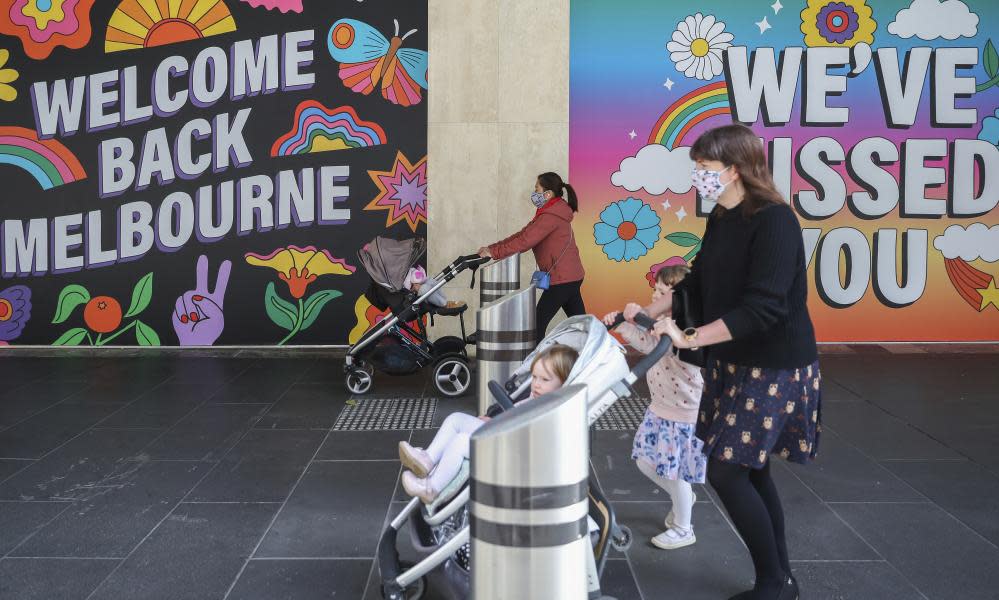Coronavirus Australia: the week at a glance

Here are all the latest developments in the coronavirus pandemic in Australia. This is Elias Visontay and it’s Friday 30 October.
Victoria out of lockdown
After more than 100 days of strict lockdowns, Melburnians were rewarded with a significant easing of Covid-19 restrictions, as case numbers for Victoria’s second wave of Covid-19 continued to decrease.
On Friday, the rolling 14-day average for new coronavirus cases in Melbourne dropped to 2.6, as authorities race to identify the transmission source of just two mystery cases. Meanwhile, regional Victoria’s 14-day average for new cases is zero, with no mystery cases.
Related: How Melbourne embraced its first day of freedom – starting at the stroke of midnight
Most retail shops, restaurants, cafes and pubs were able to – and did – reopen from the first minutes of Wednesday morning, but the ban on moving more than 25km from home still applies to metropolitan Melbourne. The state government plans to lift this restriction and allow travel to regional Victoria from 8 November if case numbers remain low.
Saturday will also be the first time in more than 100 days that premier Daniel Andrews will not front media for a daily press conference.
Sydneysiders still banned from Queensland
Queensland premier Annastacia Palaszczuk announced that from 3 November, her state will open its borders for quarantine-free arrival to the rest of New South Wales, with the exception of all of Sydney.
The announcement was made on Friday, a day before Queenslanders head to the polls to determine if Palaszczuk will be returned as premier.
While Palaszczuk had previously been criticised for her tough border stance, Friday’s decision came after she was briefed by Queensland’s chief health officer, Dr Jeannette Young, who had concerns about community transmission in greater Sydney.
Western Australia border reopens
Premier Mark McGowan on Friday announced that the state’s tough border closures that have remained in place since the start of the pandemic will begin easing.
From 14 November, Western Australia’s hard border will “cautiously transition towards a controlled interstate border”, which will include health screenings at Perth Airport and a willingness to take a Covid-19 test.
Significant entry restrictions will still apply to travellers from NSW and Victoria, including self-isolation for 14 days with a mandatory test at 11 days, as well as use of a tracking app and police checks to ensure they do not leave their place of quarantine.
Tasmania to reopen to NSW
Tasmanian premier Peter Gutwein announced on Tuesday that travellers from NSW would be able to re-enter his state without quarantining.
The rules, to come into effect from 6 November, mean that Victoria will be the only state still closed off from Tasmania.
Colbeck doesn’t feel personally responsible for aged care deaths
In the second week of Senate estimates, there were several revelations related to the pandemic, including comments from aged care minister Richard Colbeck that he doesn’t feel personally responsible for the Covid-19 deaths that have occurred in the aged care sector.
Related: Aged care minister Richard Colbeck says he's not personally responsible for 700 Covid deaths
Colbeck also told Senate estimates on Tuesday he is determined to continue in his role as aged care minister, saying his Coalition colleagues did not agree with a censure motion on him passed in the Senate.
The aged care royal commission recently heard evidence that the federal government did not have a Covid-19 response plan for the sector, however the government firmly denies this.
Looking for more coverage? Read the latest news from across the Guardian’s global network

 Yahoo News
Yahoo News 
